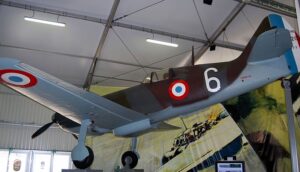Time Period: Interwar Period, World War II (WW2)
Country of Origin: United Kingdom
Type: Fighter Aircraft
Manufacturer: Hawker Aircraft
Hawker Hurricane Aircraft Overview
The Hawker Hurricane was a fighter used by the Royal Air Force (RAF) during World War II. It was designed and produced by Hawker Aircraft Ltd and served as the primary fighter for the RAF during the early years of the war before being replaced by newer models such as the Supermarine Spitfire.
The Hurricane was a single-engine, single-seat fighter and was known for its ruggedness and durability. It had a top speed of around 340 mph (550 km/h) and was armed with eight .303 machine guns. It was also capable of carrying a variety of bombs and rockets for use in ground attack missions.
Overall, the Hawker Hurricane was a reliable and effective fighter aircraft that played a significant role in defense of Britain during World War II. It was also widely used by other Allied air forces and was particularly successful in the Middle East and North Africa. Today, a number of Hurricanes are preserved in museums and private collections around the world.
The Hawker Hurricane During the War
The Hurricane entered service with the RAF in 1937 and saw its first significant combat action during the Battle of France in 1940. However, it was during the Battle of Britain, which took place from July to October 1940, that the Hurricane truly earned its place in history. Alongside the Supermarine Spitfire, the Hurricane formed the backbone of Britain’s defense against the German Luftwaffe’s bombing raids.
Equipped with eight .303 Browning machine guns mounted in the wings, the Hurricane was a formidable opponent for German bombers and fighter aircraft. Its rugged construction and strong firepower made it well-suited for dogfighting and ground attack missions. Despite being slower and less manoeuvrable than the Spitfire, the Hurricane made up for it with its robustness and firepower.
During the Battle of Britain, Hurricanes engaged in intense aerial combat with German aircraft, including Messerschmitt Bf 109 fighters and Junkers Ju 87 Stuka dive bombers. They played a vital role in intercepting enemy bombers and protecting British cities, airfields, and infrastructure from air attacks.
In short, the Hurricane’s effectiveness, combined with the bravery and skill of its pilots, contributed significantly to the RAF’s victory in the battle and the eventual defeat of the Luftwaffe’s daylight bombing campaign.
The Hurricane's Unique Construction
The primary structure of the Hurricane was constructed using a combination of metal and wood, with a fabric covering on some sections.
The fuselage, wings, and tail surfaces of the Hurricane were constructed using a tubular metal frame covered with fabric. This construction method was typical of aircraft design in the 1930s and 1940s. The frame provided structural strength and support, while the fabric covering helped to streamline the aircraft and provide aerodynamic efficiency.
The wings of early Hurricane variants were made with a wooden main spar and ribs, covered with fabric. Later variants of the Hurricane used a metal structure for the wings, but some wooden components may still have been used in certain areas.
Hawker Hurricane Specifications
- Crew: One
- Length: 32 ft 3 in (9.83 m)
- Wingspan: 40 ft 0 in (12.19 m)
- Height: 13 ft 1.5 in (4.001 m)
- Wing area: 257.5 sq ft (23.92 m2)
- Airfoil: root: Clark YH (19%); tip: Clark YH (12.2%)
- Empty weight: 5,745 lb (2,606 kg)
- Gross weight: 7,670 lb (3,479 kg)
- Max takeoff weight: 8,710 lb (3,951 kg)
- Powerplant: 1 × Rolls-Royce Merlin XX V-12 liquid-cooled piston engine, 1,185 hp (884 kW) at 21,000 ft (6,400 m)
- Propellers: 3-bladed.
Hawker Hurricane Performance
- Maximum speed: 340 mph (550 km/h, 300 kn) at 21,000 ft (6,400 m)
- Range: 600 mi (970 km, 520 nmi)
- Service ceiling: 36,000 ft (11,000 m)
- Rate of climb: 2,780 ft/min (14.1 m/s)
- Wing loading: 29.8 lb/sq ft (145 kg/m2)
- Power/mass: 0.15 hp/lb (0.25 kW/kg)
Hawker Hurricane Armament
- Guns: 4 × 20 mm (0.79 in) Hispano Mk II cannon.
- Bombs: 2 × 250 or 500 lb (110 or 230 kg) bombs.
Hawker Hurricane Image Gallery
More Hawker Aircraft

Hawker Tempest
The Hawker Tempest was a British fighter aircraft used by the Royal Air Force (RAF) during the Second World War.

Hawker Fury
The Hawker Fury was a British biplane fighter aircraft designed and manufactured by Hawker Aircraft Limited in the late 1920s.

Hawker Nimrod
The Hawker Nimrod is a British single-engined, single-seat biplane fighter aircraft built by Hawker Aircraft in the early 1930s.

Hawker Sea Fury
The Hawker Sea Fury was a British fighter aircraft and one of the fastest production single reciprocating engine aircraft ever built.











